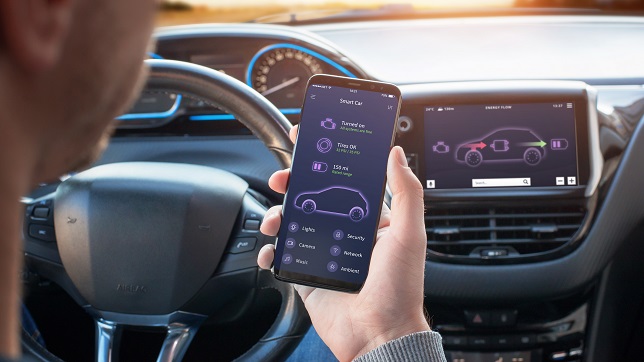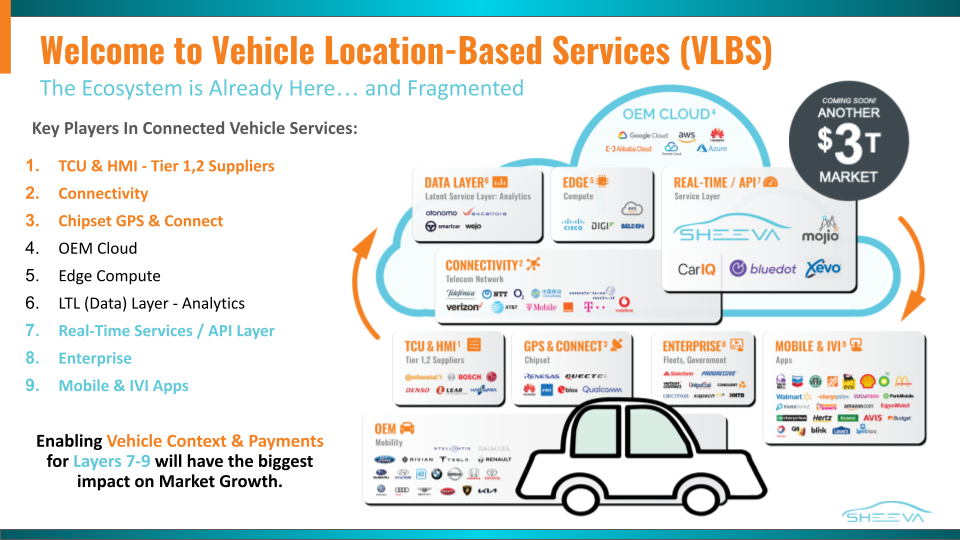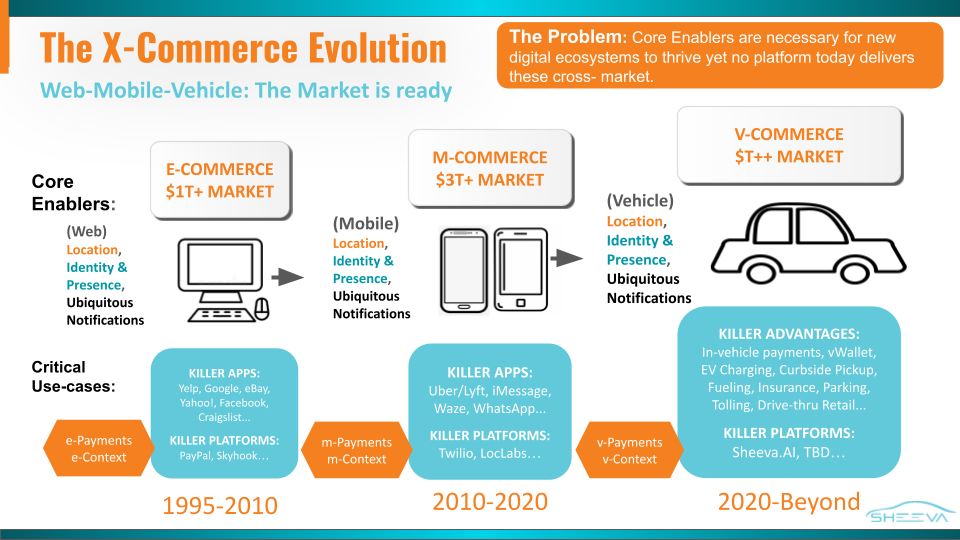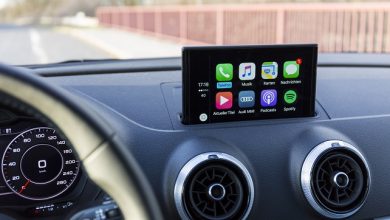Getting closer to your customers in a new connected car world
How VLBS makes in-car transactions easier and faster through comfort and trust

In-vehicle transactions in the connected car sector will become a larger slice of the growing contactless payments market, growing from $63 billion in services in 2020 to an estimated $181 billion in 2025.[1]
In India alone, the UPI digital payment system recorded 3.7 billion transactions worth nearly $65 billion just in 2021, driven by the necessities of life under the COVID-19 pandemic.[2]
At the same time, city governments around the world are looking at digital payments streams – from parking, tolls, and other points-of-service – as a less risky basis for securitization of revenue streams to fund other infrastructure projects, versus manual and less predictable collection of cash or credit cards fees. The coming focus on resilient infrastructure — from COVID, climate change and so on — could see $1 trillion in structured finance issuance, needing predictable and verifiable revenue streams to backstop it.[3]
Enabling more routine transactions seems a cold phrase for something that may be so personal to the end consumer. Those transactions that occur in and around our cars, as we move around streets, doing other things we value – transactions within transactions, if you like – are even more fraught.
What is a “transaction within a transaction?” You need more gas to get to the hospital because your loved one is suddenly ill. You’d like an extra shot of espresso in that to-go drink because it’s been a long day at work. You need to park now and get this kids’ soccer team out of your SUV because you’re already a bit late.
Location is the key to navigating this intimacy. Vehicle location-based services (#VLBS) unlocks your physical location with the precision necessary to make these transactions quicker, easier, and more frequent, with better value-added to consumers as well as to the retailers, financial institutions, and government agencies on the other side of these transactions.
With 5G deployments and inexpensive cloud resources available to connect billions of devices, including cars, and as we close in on level 5 autonomy where drivers become front-row attendees on the commute to work, more time and consideration will be given to these transactions, vehicle technology itself will improve.
As debate continues around the timing of L5 autonomy, VLBS isn’t waiting on this to generate the use cases for in-vehicle transactions. We already know what we buy in and from our cars, whether it’s a toll bridge crossing or a take-out sandwich.
As the underlying vehicle tech evolves, it’s becoming dependent on the built ecosystem to enable VLBS. Or, to mangle a popular movie phrase: “If you build the ecosystem, they will come.”
The good news is: the ecosystem is ready now. VLBS will enable the opening innings of the growing connected and autonomous vehicle marketplace.

Transactions are part of a broader discussion on the future of the automotive sector itself. While your choices in picking a vehicle for your needs or lifestyle are the result of a century’s worth of marketing around the purchase of what is often called the second most valuable asset the average household will ever purchase, the simple truth is, at its core, a car is a tool you use in everyday life.
Despite the messaging of Madison Avenue, it’s far more akin to a good cooking pot than a house.
It’s a depreciating asset that helps you do things – go to work, pick up the kids at school, help in the moving of groceries you need, and so on. It’s a container of time.
The morphing of the car-as-asset to car-as-service is built on breaking down the brick of technology that sits in your driveway. It began in the mid-1990s, with the advent of GM’s OnStar. At first, the OnStar connectivity offering was a premium product, because the underlying tech stack – including communications and positioning – was nascent and expensive. As GPS and cell service covered wider swaths of territory, the service got cheaper and penetrated almost the entire GM product line.
Starting in the mid-2010s, when level 5 autonomy first started garnering attention from investors, the promise of your car becoming an office on wheels led to some useful and some not-so-useful business models.
While some VCs saw rolling playrooms or cocktail bar, the car was becoming a mobility commodity, something more like a commuter train than a 21st-century horse-drawn carriage.
But for an industry that was “pure hardware” well before the tech sector defined it, there was a lack of understanding of the intimacy and motivations of human transactions in this commuter-train-like setting, from the urgency for some real-time grudge purchase (buying a ticket to a certain destination on a train leaving in a few minutes) and to the ingrained personalization of others (have that dinner for 4 ready to go at my last stop so I don’t have to cook)
How we got here: Trust and a sense of place
To see where vehicle location-based services (VLBS) are going, let’s take a look back at how digital commerce – from the first days of web-based transactions when Amazon was an online bookstore, to today’s more seamless mobile commerce and payments ecosystems – has evolved from its beginnings.
There are three core enablers of digital commerce: location, identity and presence, and ubiquitous notification, dating back to the first moves on commerce on what became known as the Internet in the 90s.

The first generation of digitally enabled transactions – for example, via the auction website eBay — focused on identity and presence. Where you were was known: in front of a connected computer, likely at home or at work. You “went to” the Internet, rather than it coming with you everywhere. What was key to eBay was who you were. That meant validating how much a risk you posed to their community if you didn’t operate fairly. This was a big comfort level to leap for both sides of a typical retail transaction.
This led first to new entrants creating that comfort or trust behind a brand, but often without the retail logistical savvy to deliver. By the end of the early 2000s, the world saw the battle as “online vs. bricks and mortar.” Established ticketing retailers like IRCTC took their brand online, while commoditized categories like books allowed an entrant like Flipkart.
Enter the next generation of digital commerce: mobile commerce. The advent of the smartphone placed a computer in everyone’s pocket. Tying this “terminal” to the user across an endless number of possible locations meant presence and identity took a back seat to location.
This enabled the first location-based service offerings, as well as loyalty apps designed to enable impulse purchases. Starbucks not only knew who you were, what you liked, and how you liked to pay via their app, but could see, within several dozen meters, where you physically were and could prompt afternoon coffee breaks for you with loyalty rewards.
This was the dawn of ubiquitous notifications, the nudges to get you to buy something because you’re nearby. But nearby was often not near enough to trigger an impulse buy, or, like coupons or spam email, it became easy to ignore. Human behavior is conditioned to buy candy waiting in line at checkout, but there aren’t candy displays throughout a grocery store where other lines could happen as you wait for service. It’s about timing and proximity.
Some “grudge” purchases — like entry tickets or parking fees — were not really simplified over the current way of completing those transactions. That’s because the devices used for these transactions couldn’t tell who you were standing exactly, and what you really wanted to do in the moment, even though, to an outside human observer, it seemed obvious that you were parked beside a gas pump or backing into a parallel parking space.
Opening an app, booking a parking slot in advance and time needed, and enabling a payment transaction does seem any faster than swiping that card at a POS terminal or simply handing over the cash.
Getting comfortable: The right time in the right place
VLBS tech like Sheeva.AI levers everything that’s been learned about mobile commerce and brings it into the car, where you have a precise need for that transaction – buying gas, paying a toll, buying lunch – while it knows where you physically are – which means, gas pump or takeout window – to within 2 meters versus 3-8 meters with standard GPS.
The use of APIs (Application Programming Interfaces) to interact with underlying payment, loyalty, or asset management applications makes this seamless to the end-user. By using APIs to access the underlying application’s data or use its functionality, it allows greater speed of transaction while building on the trust and behavior already known to the end-user. It gives them comfort the transaction was secure despite the fewer swipes, button pushes, or whatever may have been needed before.
What’s critical is the comfort level needed to move the decision point for the end customer, even though the contracts implicit in these transactions seem routine and safe. Even pre-Internet, the idea of swiping a credit card yourself versus handing it to an attendant required a new layer of trust. Moving those transactions online, without goods in hand was another level of trust upward.
Then, goods that needed more interaction or that could spoil – like vegetables or clothes – took another layer of trust.
Leaping from these purchases to suggested transactions took even more faith and trust. While Starbucks grants app-based users rewards points for every purchase and its app remembers how they take their latte, how does it know I need a latte at 2:15pm, when there’s a discount waiting for me if I scratch my caffeine itch?
Transactions are part of a broader discussion about the “future” of the connected or autonomous vehicle in everyday use. To get comfortable with transactions in the car, they need to feel like they belong on the ride, not just time spent scanning your phone while waiting in line.
At the gas pump or EV charging station, less time spent and more accuracy wins. Why convey the fueling type & amount to the operator on the pump if I can acknowledge one query on my in-car system? Knowing how many more kilometres of energy you have remaining, and what’s coming up down the road to manage the timing of that next fuelling stop so you can maybe take a break, is also an important context for a driver.
For tolling, acknowledgement of a correct transaction while I move at highway speed is all I want. With parking, I’d like to be pulling into a spot while a notification suggests I’ll need 90 minutes of parking time for this lunch meeting. I click once and I’m on my way.
And if you are the seller, think of what you gain with ease of use, proper context, transparency, and efficiency of these transactions.
Sheeva.AI estimates savings of 200+ seconds, or about 50% of the typical time for a transaction, at a gas pump fuelling stop.
To see how this all fits together, keep in mind that Google’s research shows people will abandon web pages that don’t load in 3 seconds, and retailers’ data shows that offers of price cuts when an impulse item has captured the mind’s eye leads to high sales conversions.
Imagine being able to capture the driver’s “mind’s eye” while they are still inside the car, before they even arrive. Once there, they can also cut transaction times in half. As well, retailers can gather critical data on customers’ needs and wants, with no further interactions needed from them.
It’s not about the hardware
For transactions leveraging VLBS, both sides of the transaction have very different hardware concerns.
For the retailer, city parking authority, or asset manager collecting the payment, with the promise of faster activation, higher throughput, and more customers, the question is how much upfront capital is needed to make my current “near-smart” technology into something VLBS-compatible? Who will service this tech and what are other ongoing costs?
Free hardware isn’t enough to convert these groups. New hardware inevitably needs tending by someone on the retailer’s team. Take a look at the number of tablets – one per third-party food delivery firm – crowding the cash register at restaurants because each delivery firm wanted to own the ecosystem. The hassle to staff for the incremental rupee in revenue from an extra customer often isn’t worth it.
For the consumer, they feel they already have the answer in their pocket: Their smartphone. The seller, too, has likely often spent money developing an app to grab attention and gather data that uses that same smartphone platform. Isn’t that good enough?
Smartphones are powerful ubiquitous tools, like your car. But VLBS would leverage consumer-facing apps that continue to build on the retailer’s relationship via gamification and rewards that already exist. How many points do I have today? What deals will I get versus the guy in the car next to me? VLBS also speeds up and simplifies the underlying transactions to let the app focus on building a richer relationship with the customer.
And VLBS technology is ultimately a software solution that bolsters the mobility-as-a-service platform that automakers and fleet operators envision. There is no special hardware infrastructure needed to power VLBS adoption aside from what’s in the vehicle. Nothing else needs to be built on either side of the transaction – no special transponder equipment, no updates to existing retail infrastructure, no RFID sensors.
Over-the-air updates to the vehicle on-board systems mean it’s less about membership in “one club” fenced in by hardware requirements, and more about managing ease of use of memberships in every “club.”
As the car moves beyond a mobility platform to a new transaction portal, making the driver’s or rider’s experience easier and richer is the ultimate goal. That means higher engagement for the end consumer, which means greater insights for auto manufacturers, retailers, and other service providers. More and more, this experience will condition the purchases, leases, or rentals of tomorrow’s vehicles. Saving them time and grief on everyday transactions will be a key differentiator — the very same differentiator that drove the growth and success of smartphones today.
Author:

Evgeny Klochikhin
Founder and CEO
Sheeva.AI
Evgeny Klochikhin, Founder and CEO Sheeva.AI, the API platform for connected vehicles, enabling large-scale Vehicle Location-Based Services (VLBS) using patented sub-2 meter geolocation to automate in-car payments for parking, tolls, fleet management, and other services.
Evgeny holds a Ph.D. in Innovation Policy and Technology Management from Manchester Business School and is the U.S. National Expert on ISO TC204.
[1] https://www.marketsandmarkets.com/Market-Reports/connected-car-market-102580117.html
[2] https://www.indianweb2.com/2021/10/upi-records-365-bn-transactions-worth.html
[3] https://www.spglobal.com/_assets/documents/ratings/research/100048329.pdf
Published in Telematics Wire


